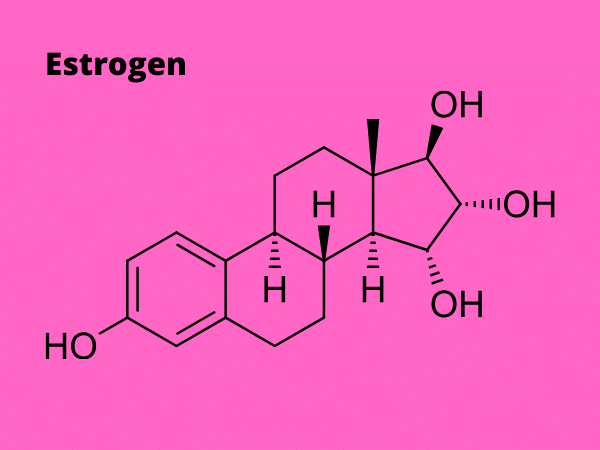Estrogen is the hormone that gives women their curves—hips and breasts. In the right amount, estrogen enables a woman to focus (no brain fog!) and contributes to balanced mood (no mood swings!), a timely (and pain-free) menstrual cycle and a healthy libido. Estrogen also positively affects the brain, skin, bones, liver and heart.
Progesterone keeps estrogen in check. These two hormones counterbalance each other. Estrogen causes you to retain salt and water; progesterone is a natural diuretic. When it comes to the breast, estrogen stimulates breast cells to grow; progesterone prevents cysts from developing in painful breasts (21).
Estrogen is a primary female sex hormone, and it is the hormone that defines women. However, estrogen can become problematic when it is high relative to progesterone. In today’s highly toxic, modern world, this very common hormone imbalance is known as “estrogen dominance”.
Estrogen also plays a role in most breast cancers. About 80% of breast cancers are “ER-positive”, or “estrogen receptor-positive”. This means that the cancer cells in the breast are growing in response to estrogen (22).
Two routes to estrogen dominance (for women):
- You have high estrogen relative to a normal progesterone level. This type of estrogen dominance is common in overweight or obese women because, in addition to the ovaries making estrogen, fat cells also make estrogen. More fat cells means higher estrogen levels. Women of normal weight who have been exposed to xenoestrogens (synthetic chemicals that have estrogen-like effects) can also be estrogen dominant. Xenoestrogens are present in combination hormone birth control pills, skin care products, cosmetics, plastics, artificial food colorings, preservatives, insecticides, building materials, chlorine and chlorine by-products, among others (23).
- You have high estrogen relative to low progesterone. This often happens, naturally, from age 35, as a woman’s fertility begins to slow somewhat. During periods of hormonal transition, like perimenopause, which typically starts around age 40 and can last up to 15 years before a woman has her final period (menopause), estrogen levels can spike wildly.
Men can also have high estrogen levels…
Factors that contribute to men having high estrogen levels include (24, 25):
» Being overweight or obese. Fat cells in the body convert male hormones (androgens) into estrogen, resulting in higher estrogen levels.
» Exposure to environmental estrogens. For example, regularly consuming conventionally raised meats.
» Heavy alcohol consumption. A study that explored the role of alcohol consumption in 74 European male breast cancer patients, ages 35 to 70 years, suggests that the risk of developing breast cancer in men increased by 16% with each additional 10 grams of alcohol consumed per day. Higher alcohol consumption levels (above 60 grams per day) was linked with increased male breast cancer risk (26).
Keep in mind: a “standard” drink contains 14 grams (0.6 ounces) of alcohol. Typical examples include a 12 oz. beer (5% alcohol by volume), a 5-ounce glass of table wine (12% alcohol by volume), and a 1.5 oz shot of distilled spirits (40% alcohol by volume)—whiskey, rum, gin, vodka, tequila (27) .
» Liver disease. A malfunctioning liver upsets hormonal balance, causing lowered androgens (male hormones) and increased estrogen. In general, people who drink more alcohol are at higher risk for alcohol-related liver disease.
For men, drinking more than 2 standard drinks per day (for women, drinking more than 1 standard drink per day) increases risk of alcohol-related liver disease, which can contribute to elevated estrogen levels (28).
» Having Klinefelter syndrome. Men with this congenital condition have lower levels of androgens (male hormones) and higher levels of estrogen, and they often develop gynecomastia (male breast tissue). Men with Klinefelter syndrome can have a 20 to 60 times increased risk of breast cancer compared to other men.
» Radiation exposure, especially in the chest area.
Continue Reading About Breast Cancer Prevention (below):
Your Breasts: What You Need to Know (Part 1)
Protect Your Breasts: Limit / Avoid the Big 3 (Part 3)
Better Breast Health: Eat These 3 Foods (Part 4)
Sources
21 The Hormone Cure. Sara Gottfried, MD, Scribner. 2013. pp. 150-153
22 BreastCancer.org.
23 WomeninBalance.org.
24 BreastCancer.org.
25 Cancer.org.
26 Ahrens W, Baumgardt-Elms C, Ménégoz F, Olsson H, Paulsen S, Simonato L, Wingren G. Alcohol drinking may increase risk of breast cancer in men: a European population-based case-control study. Cancer Causes Control. 2004 Aug;15(6):571-80.
27, 28 Yale Medicine. Alcohol-related liver disease.


